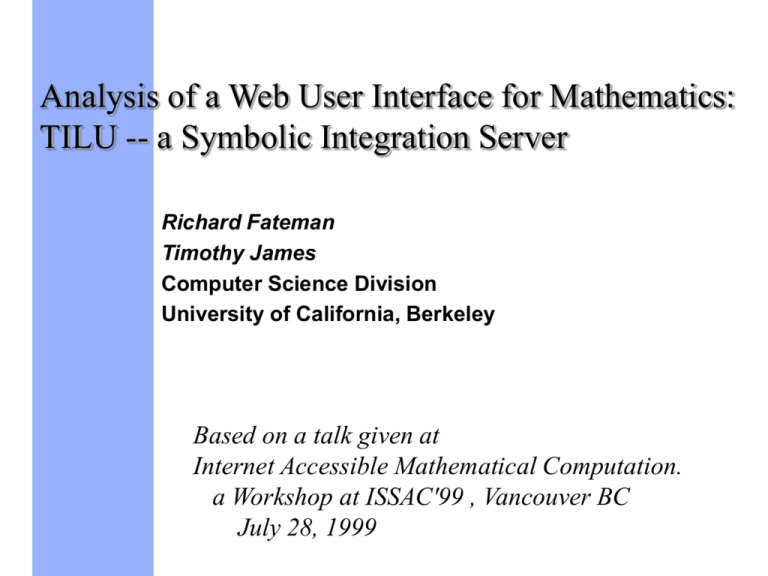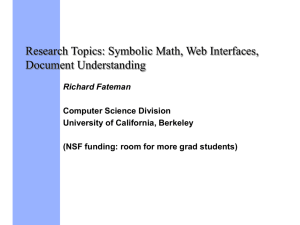powerpoint slides - University of California, Berkeley
advertisement

Analysis of a Web User Interface for Mathematics:
TILU -- a Symbolic Integration Server
Richard Fateman
Timothy James
Computer Science Division
University of California, Berkeley
Based on a talk given at
Internet Accessible Mathematical Computation.
a Workshop at ISSAC'99 , Vancouver BC
July 28, 1999
I - What does TILU do?
A (simplified) interaction
A brief defense of why it is
interesting to look up integrals this
way
Has processed some 250,000 queries
or so (March, 2004)
R. Fateman/ Web Math Interface
2
TILU Table of Integrals Look Up
Welcome to TILU, a web server that looks up
integrals in a reference table.
If you have never used this page before, or if
you need some review on the syntax for
describing your integral, please be sure to check
in the frame on the left. Once you have figured
out how to ask your question, type or paste the
integrand in the big box below:
Select language
Indefinite Integral
X^2*Sin[a x]
R. Fateman/ Web Math Interface
3
Lookup begun Jul 12, 1999 16:19:29, completed in 140 ms.
processor time, 171.0 ms. elapsed real time. Actual cpu time in
computing the answer: 0 ms.
The result of looking up this integral
2
INTEGRATE(X SIN(A X), X) =
-3
2 2
-2
COS(A X) A
(2 - A X ) + 2 X SIN(A X) A
R. Fateman/ Web Math Interface
4
Lookup begun Jul 12, 1999 16:24:40, completed in 120
ms. processor time, 139.0 ms. elapsed real time. Actual
cpu time in computing the answer: 0 ms.
2
INTEGRATE(X
ERF(X), X)
was not found.
We tried sending your integral request to Wolfram's
Integrator and their answer was:
(1/(3*Sqrt[Pi]) + x^2/(3*Sqrt[Pi]))/E^x^2 +
(x^3*Erf[x])/3
R. Fateman/ Web Math Interface
5
Why is a web lookup interesting?
Inferiority of algorithmically generated answers in
some cases. Not just an integration issue but a
simplification issue. Tables have neat answers when
algorithms give poor or no answer; (of course
algorithms sometimes do win...so the best approach
is probably to combine).
Once you get the integrand and limits into the
system, we can further process them, including
calling Mathematica, Maple, Macsyma, ... servers.
Provides insight into storage and retrieval of
mathematics generally on the web.
– other reference material, textbooks.
– An integral archive/knowledge base for all the net.
R. Fateman/ Web Math Interface
6
II- Math is Apparently Hard to Type
This is a summary report from June 1, 1999 --July 12, 1999, as
we prepared these slides.
519 user-connections to our site.
– About 75 of the inputs were so ill-formed the parser rejected
them.
– Of the remaining 445, we count only 300 distinct integrands
Of the 300 unique Mathematica expressions,
– 110 were illegal inputs, typically because of
• the misuse of sin(x) for Sin[x].
• Operators missing: ax or xcoshx instead of a*x or x Cosh[x].
• insertion of "dx" or "integrate."
– Many more (156) we “legalized” by allowing sin[x] instead of
Sin[x], e instead of E etc.
Only 34 inputs were fully syntactically correct.
R. Fateman/ Web Math Interface
7
Speculation Regarding Users
Most don’t know much about computer algebra or
numerical mathematics programming languages
Most don’t know about computer typesetting
programs (TeX, Expressionist)
Of the dozens of people who meant
s sin x dx = - cos x
but got
s sin x dx = sin * x2/2
Only one complained.
R. Fateman/ Web Math Interface
8
III- Possibilities for Improving the
User Interface
– Very liberal “Mathese” grammar (done(RWarfield)
– Off-the-shelf equation editor
– More Feedback to the typist
– Traditional “error detection”
– Traditional “error correction”
– Forced Choices
– The calculator model (done, 2002 BISCOTTI, GC)
– The box-prompt model
• typewriter input
– hand-written input (in progress, 2004)
– SPEECH (in progress, 2004)
R. Fateman/ Web Math Interface
9
Mathese grammar
– Not Context Free Grammar. Filled with
ambiguity !
– Resolution based on semantics, heuristics
• cos x, cos(x), cos[x], cos{x} cosx xcosx
• a*x+b, a x+b, ax+b
• d*x, d x, dx
• 1/2pi ??? 1/(2pi) or .5*pi ?
– Some of the same problems arise in parsing
TEX into math
R. Fateman/ Web Math Interface
10
Mathese grammar (continued)
– Texts and references are “informal” too, It’s
not just casual hand-waving slobs who do this!
• G&R 3.884..
... cos a | b | exp( a | b | )
– Ps, this formula is wrong...
• 4.384.4
.. ln(sin p x) cos (2n + 1) p x dx
R. Fateman/ Web Math Interface
11
Math-oriented Off-the-Shelf Editors...
The idea here is to use a familiar editor or formalism to
assemble the necessary pieces to define the math.
– Cons (depending on choice):
• Not necessarily familiar or intuitive!
• Added expense
• Typesetting goals do not resolve ambiguous
Math semantics (= mathese equivalent)
• Not standard or integrated
• Insufficient generality (overly constrained)
R. Fateman/ Web Math Interface
12
Existing software (continued)
– Pros (depending on choice)
• COTS support, platform independence,
standard conformance (TeX, MathML..)
• Document-Centric view may be a BIG WIN if
there is a CAS inside
– Scientific Workplace (Maple, Mathematica)
– Frame (Milo)
• Some are really pretty thoughtfully
designed if you are willing to learn them!
R. Fateman/ Web Math Interface
13
A list of a few prospects
MS Equation, Frame, Mathematica, TeX, Milo,
LiveMath/MathView/Theorist/Expressionist,
Mathtype, EzMath, Scientific Word, WebEq,
Swift. Macintosh Graphing Calculator...
R. Fateman/ Web Math Interface
14
Examples of error detection/correction
• Expression has no “x” in it. xcoshx gets fixed
x cosh x
to
• Expression has “dx” or “integrate” in it: remove.
• Improbable though correct Mathematica: sin(x)
should be sin [x]
• Insufficient closing brackets repaired.
• Misspellings corrected (uncommon).
• Diagnostic aids: Better rephrasing of the
question.
R. Fateman/ Web Math Interface
15
Familiar System Paradigms
–
–
–
–
–
–
Menu (extensible) + pre/post selection
Fortranish [Bonadio, Theorist]
Copy/Paste of completed subexpressions
Calculator (TI, HP, ?)
Direct Manip. (Pacific Tech, Avitzur’s NuCalc)
Mathematica (Soiffer, Mathscribe)
S
R. Fateman/ Web Math Interface
16
Idiotproof/ Forced-Choice/ Structured Input
for the Web
– More nearly free-form, yet forbids incorrect syntax;
disambiguates murky forms (based on semantic
associations)
– Menus/templates are used primarily for information.
– Input could be keyboard only, stylus only.
• Here’s the general idea: insert in the box.
cos
cos (
R. Fateman/ Web Math Interface
)
17
Details: Typed Boxes Clarify Choices
–
–
–
–
“Infix” Verbs (+, *, “space”, -, /)
Nouns or Noun Phrases (x, y, z, x+y*cos(z) )
Function Name (cos sin tan {f, g, …}, derivative)
Lists “a,b,c”...
“noun” only
“noun or verb”
NEXT
optional
x2+y
xy
x
x
R. Fateman/ Web Math Interface
x*y
18
Selection of previous expressions
Select box by click or backtab, arrow
2
cos ( x + y ) + y
[
2
cos ( x + y ) + y
Insert brackets in pairs only
]
– Insert/Delete brackets, Show/Hide boxes, Name?
– Appeal to menu if necessary for more structures: user-templates?
R. Fateman/ Web Math Interface
19
Following our earlier example
Tab, 2,+
cos (
)
cos ( x
)
...
2
cos ( x +
)
– direct manipulation design intuition is tricky… how does the user
know to hit <tab> or click with mouse (where)?
– time will tell if this can be made to work
R. Fateman/ Web Math Interface
20
If you keep looking, you will find almost anything
… Swift (free Java application)
While we haven’t gotten Swift to work, we have corresponded with its
authors. It looks interesting; we’d like to have handwritten input as an
option, too.
R. Fateman/ Web Math Interface
21
Biscotti, a Java applet
– Undergrad project (E. Heien, Gifford Cheung)
– Based on Macintosh Graphing Calc, but written in Java
as an applet (cf. NuCalc from Pacific Tech.)
– Fortranish + “calculator keyboard”
– Additional features: “send to TILU” key
• Uses Lisp syntax and TCP/IP socket
– Extensions in progress or contemplated
• Can send “any” message, by agreement to server (subject
to Java restrictions, unfortunately)
• Could be used as base for other calculations, e.g. Potential
front-end for CAS more generally
• Simple environment (local values)
• Other output forms (XML)
• Other communication styles (Java inspired)
R. Fateman/ Web Math Interface
22
Future Prospects for Tilu
– More ambitious web server processing
• larger lookup tables, pseudo-CAS, more tasks
(ODEs?) Sums, Products, Transforms
• Put the Mathese parser on-line
– Hooking up to XML based front-ends (via a
Lisp XML reader)
– Detailed design and implementation for
MathSE, keyboard/ stylus-handwritten input
– Lisp mini-plugin front end replacing Java?
– Installation on CD or web site for Academic
Press/ Gradshteyn & Rhyzik
R. Fateman/ Web Math Interface
23








